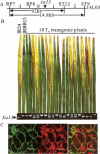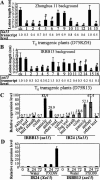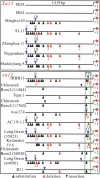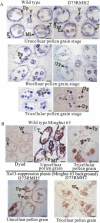Promoter mutations of an essential gene for pollen development result in disease resistance in rice
- PMID: 16648463
- PMCID: PMC1472899
- DOI: 10.1101/gad.1416306
Promoter mutations of an essential gene for pollen development result in disease resistance in rice
Abstract
Disease resistance and sexual reproductive development are generally considered as separate biological processes, regulated by different sets of genes. Here we show that xa13, a recessive allele conferring disease resistance against bacterial blight, one of the most devastating rice diseases worldwide, plays a key role in both disease resistance and pollen development. The dominant allele, Xa13, is required for both bacterial growth and pollen development. Promoter mutations in Xa13 cause down-regulation of expression during host-pathogen interaction, resulting in the fully recessive xa13 that confers race-specific resistance. The recessive xa13 allele represents a new type of plant disease resistance.
Figures





References
-
- Belkhadir Y., Subramaniam R., Dangl J.L. Plant disease resistance protein signaling: NBS-LRR proteins and their partners. Curr. Opin. Plant Biol. 2004;7:391–399. - PubMed
-
- Buschges R., Hollricher K., Panstruga R., Simons G., Wolter M., Frijters A., van Daelen R., van der Lee T., Diergaarde P., Groenendijk J., et al. The barley Mlo gene: A novel control element of plant pathogen resistance. Cell. 1997;88:695–705. - PubMed
-
- Chu Z., Fu B., Yang H., Xu C., Li Z., Sanchez A., Park Y.J., Bennetzen J.L., Zhang Q., Wang S. Targeting xa13, a recessive gene for bacterial blight resistance in rice. Theor. Appl. Genet. 2006;112:455–461. - PubMed
-
- Dangl J.L., Jones J.D. Plant pathogens and integrated defence responses to infection. Nature. 2001;411:826–833. - PubMed
Publication types
MeSH terms
LinkOut - more resources
Full Text Sources
Other Literature Sources
Molecular Biology Databases
